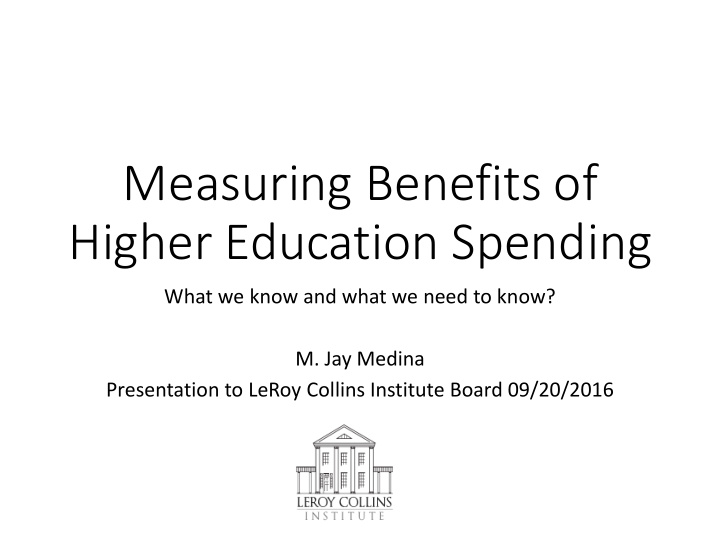



Measuring Benefits of Higher Education Spending What we know and what we need to know? M. Jay Medina Presentation to LeRoy Collins Institute Board 09/20/2016
FSU Economic Impact 1 • Report for 2014-15 school year, released April 2016 • $10 Billion in total economic activity • Gain in earnings for Public College graduates versus Public High School graduates. • Present value of 30 years of estimated earnings gain. • $7.9 billion from FSU • So $2.1 billion contribution based on expenditures. • Standard economic impact analysis • No visitor spending or technology licensing. • $50,400 per student 1 Economic Contributions of the State University System of Florida in 2014-15, Center for Economic Forecasting and Analysis
Other Florida Universities • UF: $22.9 Billion, $10.2 Billion from graduates, $4.6 Billion from UF Health, $8.1 Billion from other expenditures, $160,400 per student. • USF: $11.1 Billion, $8 Billion from graduates, $3.1 Billion from expenditures, $63,800 per student. • UCF: $11.9 Billion, $9.6 Billion from graduates, $2.3 Billion from expenditures, $37,800 per student. • NCF: $135 Million, $84 Million from graduates, $51 Million from expenditures, $63,750 per student.
Florida College System • $26.6 Billion, $25.2 Billion from CHE (Credit-Hour- Equivalents), $1.4 Billion from spending, $1,650 per student. • This analysis is not very comparable: • Tries to calculate added value of Florida College System compared to alternative spending • Added earnings reduced 62.5% to account for possible substitution effects. • Undoing those, $67.2 Billion from CHE and $11.5 Billion gross effect of spending, $13,500 per student.
Economic Impacts • Of 49 university impact studies reviewed, the lowest impact per student, $10,500 came from University of Wyoming, that similar to the Florida College System, calculated only the effect of spending that would not otherwise have occurred, coming from out-of-state. • The highest economic impact, $560,000 per student, came from University of Pennsylvania. They claimed only $7 Million came from their health system, which seems unrealistic.
Bottom Line • Very hard to compare different Universities because of diverse methodologies. • Some studies don’t include any impact of alumni; these impacts tend to be very large. For comparison, I excluded those impacts when I could. • Each study includes and excludes different considerations, some do not include a multiplier effect of spending. • Standard deviation of impact per student is $100,000 across studies.
Return on Investment • A second way to look at things: • Attempts to evaluate the societal return to each dollar given to higher education. • The value can be somewhat complicated as above: individual gains, revenue gains, and non-monetary benefits.
Public University Funding by State per FTE student District of Columbia Iowa Vermont Texas Delaware Connecticut . Alabama Ohio. Wyoming. Nebraska Illinois . United States North Carolina . Colorado Oklahoma Massachusetts Minnesota. New Jersey . South Carolina . Montana. Kansas. West Virginia Georgia . Arizona. Idaho Florida 0.00 10.00 20.00 30.00 40.00 50.00 60.00
Return on Investment: Enrollment • Different studies tend to find similar effects in trying to estimate impact of changes in spending on enrollment. • About 3-5% increase in enrollment for each $1,000 in per student funding. • As discussed in the economic impact research, a large part of University impacts come through graduates.
Return on Investment: Research • A 2014 study by an FSU Faculty member found that shocks in funding for Research Universities had a statistically significant impact on local area economic activity, especially in areas where the local industries had research relationships with Universities. Kantor and Whalley (2014)
Return on Investment: Faculty? • Florida Public Universities also have the highest student/faculty ratio in the nation with 21.3 FTE students per FTE faculty member • Not much data on actual impacts of student/faculty ratios. • But high student/faculty ratios and low resources make it difficult to attract and retain good faculty which may contribute in many ways.
Economic Impact vs. Return on Investment • Economic impact studies are very common. • But they do not really tell us much about how much we get from higher education spending. • Return on investment studies attempt to estimate return on revenue increases. • However, they focus on increasing enrollment, which is an incomplete way to assess return on investment.
Recommend
More recommend